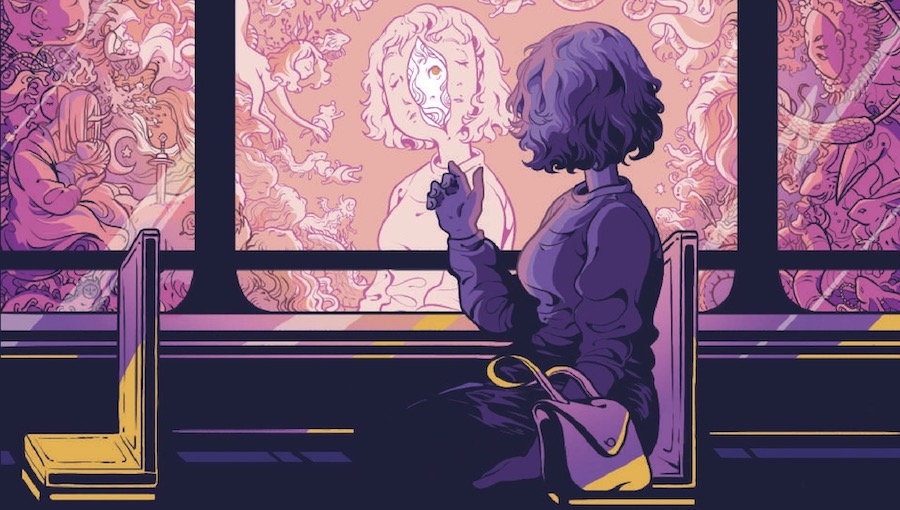In Don’t Go Without Me, cartoonist Rosemary Valero-O’Connell brings us three tales about the fragility of existence, memory, and intimate connection. We encounter fantastic creatures, mind-bending technology, and imaginative new worlds. And we discover the strangest frontier of all: the labyrinth of human emotion.
The first of these stories, the titular “Don’t Go Without Me,” is an imaginative and melancholy tale of two lovers with the most intimate of connections…until they’re separated in a parallel universe. Slipping through a crack between two overlapping worlds, the lovers are intent on having the perfect date, filled with adventure and the discovery of new things. But they are separated on arrival, and we follow the protagonist as she exchanges stories with the strange (and cutely creepy?) native inhabitants for clues to her partner’s whereabouts. But with every detail she shares, she forgets more and more until it is clear she is in danger of losing the very thing she values most. Intimacy is like magic, so easy to let slip through your fingers.
In “What Is Left,” we find ourselves stuck in a crippled spacecraft along with Isla, a biomechanic working in its engine room. This spacecraft runs on the theta waves created from the mind of a human donor. After a catastrophic accident in this human engine, Isla finds herself afloat in the “web of neuroprojections” created from someone else’s memories…and finds herself falling in love with her new surroundings. Uncertain if there is anyone left alive on her ship, Isla is reluctant to break away from this sudden and intimate immersion into another person’s life. “What Is Left” masterfully blends science fiction, technology, and the power of human connection.
At the center of “Con Temor,” Con Ternura is a mysterious sleeping entity, a giant whose presence both threatens and comforts the people living in its shadow. This community lives in a constant state of uncertainty about what will happen when this giant wakes. Will it destroy everything or act as a benevolent protector? Each individual member of this strange world must find their own unique way of coping with this imposing and inextricable reality. This is a poetic tale that illustrates our search for meaning and satisfaction in a life with no guarantees.
Valero-O’Connell’s illustrative style is both romantic and bold. She manages to convey tremendous emotion in panels with little to no dialogue. The color palette for each story is simple, sticking to two or three shades of pink, greys, purples, and blues. O’Connell’s careful control of this palette makes it easy for the reader to navigate between the various states of reality and memory that much of the narrative winds between.
Across all three stories, we find overarching themes of intimacy, memory, and loss. The tone is suitably romantic and melancholy. We find ourselves wanting to linger in places that are both profoundly sad and beautiful. Valero-O’Connell has succeeded in creating utterly new worlds inhabited with strange, new creatures and technologies, yet the reader is able to always find familiar ideas and emotions to center themselves. All three tales end with open questions, reminding us that resolving the questions these themes introduce is an ongoing process. These are stories that matter, because they shine a light on humanity’s profound need to connect and the daily struggle to do so.
>>> Footnote:
Comic readers will recognize Rosemary Valero-O’Connell from her work on DC’s Gotham Academy and BOOM! Studios’ Lumberjanes and Steven Universe, as well as the illustrator of Mariko Tamaki’s Laura Dean Keeps Breaking Up with Me from First Second. In 2018, Valero-O’Connell was nominated for two Eisner Awards, Best Coloring and Best Single Issue / One-Shot, for the single-issue release of What Is Left.
Creative Team: Rosemary Valero-O’Connell (writer/artist)
Publisher: ShortBox
Click here to purchase.

